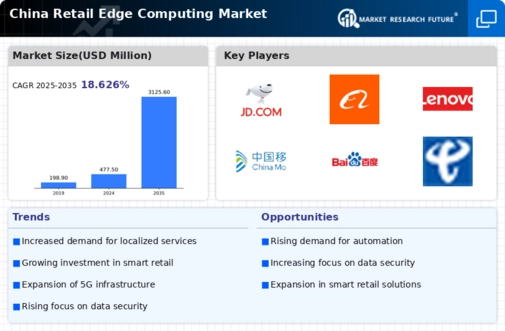Expansion of 5G Infrastructure
The rollout of 5G technology in China is significantly impacting the retail edge-computing market. With its high-speed connectivity and low latency, 5G enables retailers to deploy edge-computing solutions more effectively. This infrastructure expansion allows for seamless integration of IoT devices, enhancing the ability to collect and analyze data in real-time. As of November 2025, it is estimated that over 50% of urban areas in China have access to 5G networks, facilitating the adoption of advanced retail technologies. Retailers are likely to capitalize on this infrastructure to improve customer experiences and streamline operations, thus propelling the growth of the retail edge-computing market.
Focus on Supply Chain Optimization
Supply chain optimization is becoming increasingly critical in the retail edge-computing market in China. Retailers are leveraging edge-computing solutions to enhance visibility and control over their supply chains. By processing data at the edge, retailers can monitor inventory levels, track shipments, and respond to disruptions more effectively. This approach not only reduces operational costs but also improves customer satisfaction by ensuring product availability. As of November 2025, it is estimated that retailers utilizing edge-computing for supply chain management can achieve cost reductions of up to 15%. This focus on optimization is likely to drive further investment in edge-computing technologies within the retail sector.
Rising Demand for Real-Time Analytics
The retail edge-computing market in China is experiencing a surge in demand for real-time analytics. Retailers are increasingly seeking to leverage data at the edge to enhance decision-making processes. This trend is driven by the need for immediate insights into customer behavior and inventory management. According to recent estimates, the market for edge analytics in retail is projected to grow at a CAGR of approximately 25% over the next five years. Retailers are investing in edge-computing solutions to process data locally, reducing latency and improving operational efficiency. This shift towards real-time analytics is likely to transform how retailers interact with customers, optimize supply chains, and manage resources, thereby driving growth in the retail edge-computing market.
Growing Emphasis on Personalization Strategies
The retail edge-computing market in China is witnessing a growing emphasis on personalization strategies. Retailers are increasingly utilizing edge-computing solutions to analyze customer data and deliver tailored experiences. By processing data locally, retailers can quickly adapt to individual customer preferences and behaviors, enhancing engagement and loyalty. Recent studies suggest that personalized marketing can increase sales by up to 20%. As retailers strive to differentiate themselves in a competitive landscape, the ability to offer personalized experiences through edge-computing is likely to become a key driver of growth in the retail edge-computing market.
Increased Investment in Smart Retail Technologies
Investment in smart retail technologies is a key driver of the retail edge-computing market in China. Retailers are increasingly adopting technologies such as AI, machine learning, and IoT to enhance operational efficiency and customer engagement. The market for smart retail solutions is expected to reach approximately $30 billion by 2026, with edge-computing playing a crucial role in processing data generated by these technologies. By utilizing edge-computing solutions, retailers can analyze customer interactions and inventory levels in real-time, leading to more informed business decisions. This trend indicates a growing recognition of the importance of technology in the retail sector, thereby fostering growth in the retail edge-computing market.

















Leave a Comment